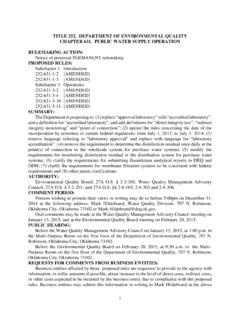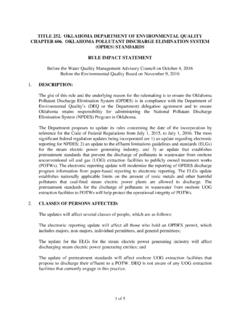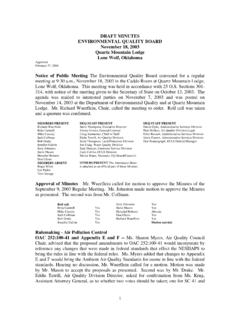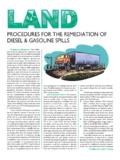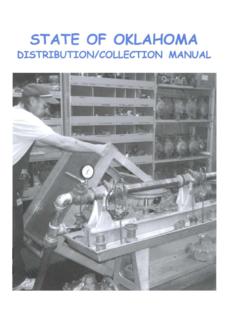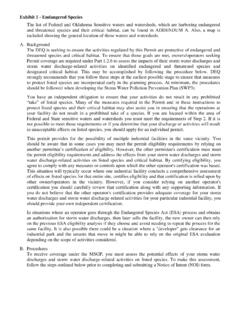Transcription of THE TITLE V PROGRAM - GUIDANCE
1 Box 1677. Oklahoma City, Oklahoma 73101-1677. THE TITLE V PROGRAM - GUIDANCE . This GUIDANCE is a compendium of frequently asked questions and answers concerning the TITLE V PROGRAM in Oklahoma designed to assist you in completing your permit application. The answers given here are based on the latest information available and represent our best understanding of the PROGRAM . However, be aware that they may be subject to change at a later time. If you have any questions concerning this document please feel free to contact staff of the Air Quality Division at (405) 702-4100. THE PROGRAM ..1. THE APPLICATION PROCESS.
2 7. THE APPLICATION FORM ..11. PART 1 ..12. PART 1a ..13. PART 1b ..14. PART 1c ..16. PART 3 ..16. PART 5 ..17. PART 5a ..18. PART 5b ..19. PART 5c ..20. THE PERMIT ..20. THE PERMIT ISSUANCE PROCESS ..24. TITLE V GUIDANCE APRIL 9, 2012. THE PROGRAM . 1. Why does Oklahoma implement the TITLE V PROGRAM ? DEQ has as one of its primary goals to "Encourage common sense approaches to environmental regulation by obtaining authority to operate all federal programs duplicating state authority.". The Clean Air Act Amendments (CAAA) of 1990 mandated a nationwide system of operating permits for major sources similar to the air PROGRAM that Oklahoma had in place for some years.
3 Thus, obtaining authority to operate the TITLE V PROGRAM is consistent with our public policy philosophy that, The best government is that government closest to and therefore most responsive to the people. ; "The best government is that government that is least intrusive of private resources," and "The best government is that government that is least stressful on its constituencies.". 2. How do Part 70 permits fit into the permit PROGRAM ? Oklahoma operates a dual permitting system. In general, a construction permit is required for construction of a new source, and for modification to an existing source, provided certain criteria are met.
4 An operating permit application is required to be submitted within 180 days after each emission unit in the permit becomes fully operational. Permits are classified as either minor or major, depending upon the levels of emissions and the particular pollutant emitted. A major operating (Part 70) permit is required of those facilities with the potential to emit (PTE) 100 tons per year (TPY) or more of any criteria pollutant, or 10 TPY or more of any one hazardous air pollutant (HAP), or 25 TPY or more of any combination of HAPs. A definition of major stationary source is found in OAC 252:100-8-31. Listed major stationary sources with PTE of 100 TPY or more of any pollutant subject to regulation, and those unlisted sources with PTE of 250 TPY or more must also meet Prevention of Significant Deterioration (PSD) requirements.
5 If a source can demonstrate by either operational constraints or control equipment that the facility would never realize its potential to emit major amounts then it qualifies as a minor source, which is typically called a "synthetic minor." A general operating permit (and Authorization to Operate) is also available for certain TITLE V facilities. For a fee and appropriate documentation the DEQ will provide an "Applicability Determination" as to which type of permit is required. 3. What is the cost associated with getting a Part 70 permit? Fees for processing various TITLE V applications are found in OAC 252 These permit processing fees are payable at the time of application and are non-refundable.
6 An annual operating fee, based on emissions information submitted with the Annual Emissions Inventory, adjusted yearly, is also assessed according to either (owner/operator choice) actual emissions (from test or monitoring data) or allowable emissions (permitted) submitted for the year on the Turn-Around Document. 4. Who can I contact at DEQ for information/assistance on TITLE V requirements? Applicants needing general assistance should contact our Customer Service Division, toll free at 1-800-869-1400, or for specific assistance contact the Air Quality Division at (405) 702-4100. The Air Quality Newsletter that is currently distributed to those on the mailing list for Air Quality Council announcements will also contain updated regulatory and policy information on TITLE V and other programs .
7 The agency also has a website at // OKLAHOMA DEPARTMENT OF ENVIRONMENTAL QUALITY--AIR QUALITY DIVISION PAGE 1. TITLE V GUIDANCE APRIL 9, 2012. 5. How do I know if I need to submit a TITLE V application? In general, a Part 70 permit is required of those facilities with PTE of 100 TPY or more of any criteria pollutant, or 10 TPY or more of any one HAP, 25 TPY or more of any combination of HAPs, or 100,000 TPY of greenhouse gasses (GHGs). If a source can demonstrate by either operational constraints or control equipment that the facility will never realize its potential to emit in major amounts, then it qualifies as a minor source (a "synthetic minor") and a Part 70.
8 Permit is not required. Certain other sources, such as any affected source subject to the Acid Rain Rules, any solid waste incinerator subject to Section 129(e) of the CAA, or landfills, may be required to obtain a Part 70 permit regardless of their PTE. 6. What is a synthetic minor permit? TITLE V regulations allow a source that would normally be required to obtain a Part 70 permit to accept operational or control equipment limitations so that its PTE does not exceed major source levels. Thus, it is exempt from obtaining a Part 70 permit. This minor source permit is typically called a synthetic minor permit.
9 The traditional DEQ Permit Application Guide, containing DEQ Form 884, is used for these sources. There are both advantages and disadvantages to electing the synthetic minor option. Advantages include not having to collect and submit facility-wide information required for a TITLE V application, not having to prepare a detailed emissions inventory for the facility, not having to meet TITLE V annual reporting and recordkeeping requirements, and possibly being exempt from additional permitting and emissions fees. Disadvantages include being required to limit potential emissions, and not having a Part 70 permit shield.
10 7. What is an Applicability Determination? An Applicability Determination (AD) is a service provided to industry to determine whether a particular source or operation is subject to the requirements of a rule. The AD fee may be applied to any subsequently required permit. Generally, the application must contain the same information as a regular permit application. 8. Are emissions levels for insignificant activities included in the determination of whether you are subject to TITLE V? A list of those units that meet the definition of insignificant (OAC 252 ) must be provided in the application. However, quantification of emissions levels for TITLE V are required only to the extent needed to determine major source status, to verify the applicability of a specific requirement, or as necessary to compute a permit fee.
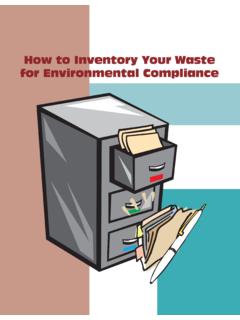
![[NOTICE OF RULEMAKING INTENT] - Welcome to …](/cache/preview/0/e/b/1/6/4/5/2/thumb-0eb16452057ea1b264c252307d7f8015.jpg)
